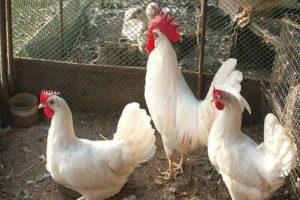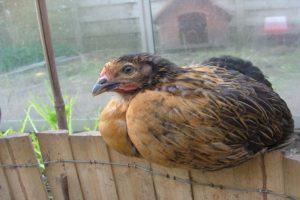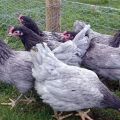Description and history of origin of Paduan breed chickens, rules of maintenance and care
Paduan chickens look unusual. These birds have a decorative appearance and serve as a real decoration of the poultry yard. The birds are decorated with an interesting crest that looks original. In order for the raising of chickens to be successful, it is recommended to properly care for them. At the same time, it is worthwhile to properly organize the space in the chicken coop and ensure proper feeding.
Origin story
Paduanas were bred in the seventeenth century in Italy - in the city of Padua. The name of the breed is connected with this. Chickens came to Russia in 1763. They were brought by German merchants. Initially, the birds were the descendants of the Russian Pavlovsk breed. There is also a version of the origin of birds in English farms, from which they came to Italy. Today there are different types of such chickens - blue, silver, golden.
Currently, the breed is classified as decorative. It is bred to decorate the poultry yard and participate in exhibitions. At the same time, there are breeders who raise birds to get tasty dietary meat. According to its characteristics, it surpasses the meat of other chickens.
Description and characteristics of paduan chickens
Paduan chickens are distinguished by their decorative appearance. They are characterized by a number of features.
Exterior of the breed
Distinguishing these birds from other breeds is easy. On the head of the birds there is a lush crest. Moreover, they lack scallops, lobes and other processes. The bottom of the neck is covered with a dense layer of feathers. Therefore, it seems massive. When moving, the body of chickens is located at an angle of 45 degrees. For birds, blue or purple color of the limbs is characteristic. Chickens have a strong curved beak. Sometimes it has a pale blue tint - it all depends on the genes.
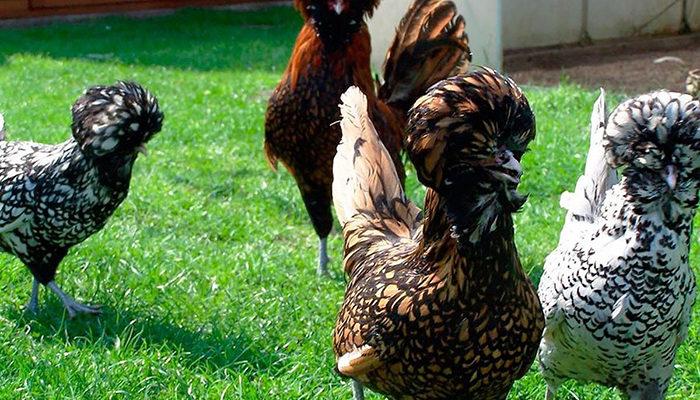
The tail of these birds is long and wide. This applies to both chickens and roosters. This part of the body makes the birds proud and graceful. The birds are characterized by a rounded breast that protrudes slightly forward. In addition, it is worth noting the impressive length of the limbs.
Varieties of paduan
There are several varieties of chicken breeds, each of which has a unique feather color.
Shamoa
This species of birds is characterized by a mixed shade of feathers. The middle is golden brown, and the border is white.
Silvery
Such birds are distinguished by white feathers that have a black border.
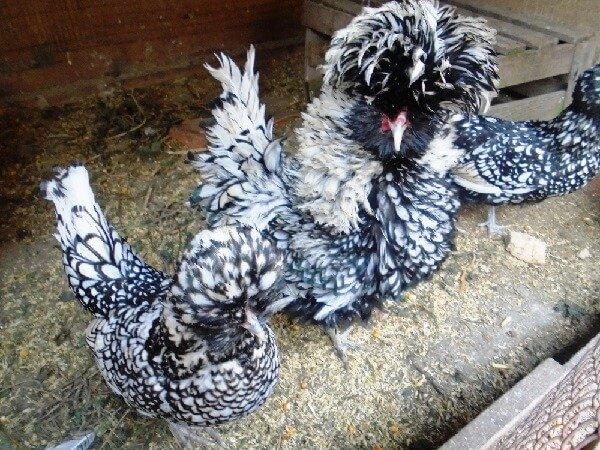
Golden
This is a spotted bird species.The birds are distinguished by golden yellow feathers. They also come in golden red. The plumage border is black.
Bird productivity
Decorative birds do not have high egg production parameters. They are capable of laying no more than 110-120 eggs weighing 40-50 grams per year. However, the breed is not bred for this purpose. It is grown mainly for the purpose of obtaining offspring. Egg production of birds begins relatively late. The birds lay their first eggs at 6-7 months.
Character traits
The birds are calm and balanced in nature. They are non-conflicting, trusting and friendly. Birds are highly intelligent and easy to train. Chickens can be taught to eat from hands or sit on the shoulders of the owner. If you want, you can make the bird a real pet.
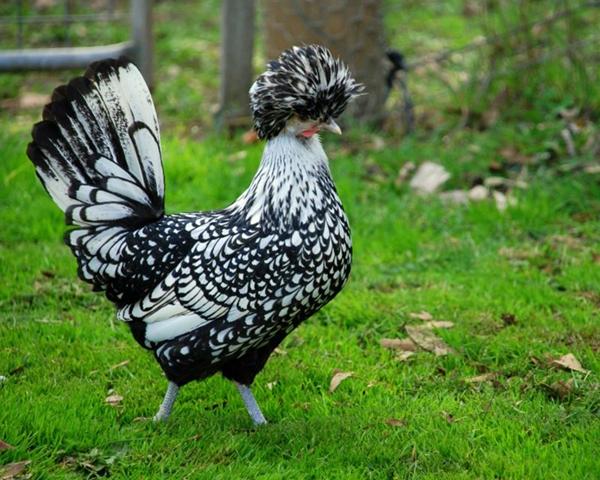
Sometimes poultry farmers note the irascibility of birds, the manifestation of jealousy or other negative characteristics. However, this is more related to the individual characteristics of birds and depends on the conditions of detention. Cocks are more likely to show aggression. At the same time, chickens are characterized by a calm disposition.
Advantages and disadvantages
Before starting to breed chickens, it is recommended to analyze their characteristics. The key benefits of birds include the following:
- beautiful and unusual appearance;
- various color of feathers;
- the ability to train and train birds;
- lean meat - it is permissible to include it in the diet;
- the possibility of using down for filling blankets and pillows.
At the same time, chickens also differ in certain disadvantages. These include the following:
- bad hatching instinct;
- cold intolerance;
- tendency to colds;
- low productivity.
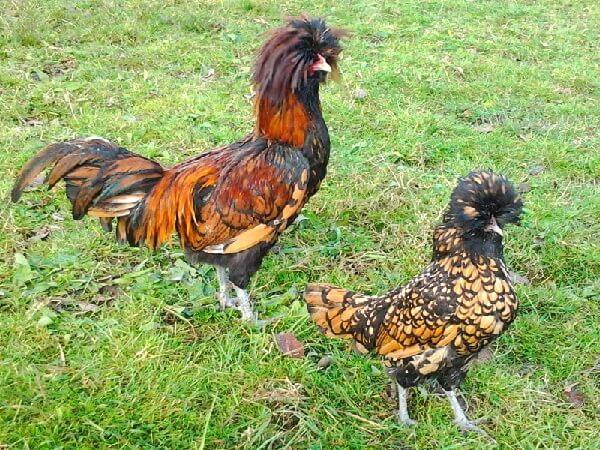
Subtleties of maintenance and care
In order for the birds to grow and develop normally, they are advised to provide the correct conditions for keeping.
Chicken coop requirements
Chickens need a reliable chicken coop. Don't build it out of brick or concrete. These materials absorb cold. It can be quite difficult to heat such a room. In order for the birds to feel good and not get sick, the temperature should be at least + 10-14 degrees. In addition, complete protection against drafts is important.
It is not recommended to make a concrete floor in the house. Chickens can peck at it, which will lead to damage to the legs and beak. Such coverage is especially dangerous in winter. It leads to cooling of the paws, which causes dangerous colds.
The best option for making a floor is tamped soil or clay. It is also acceptable to use wood flooring or sawdust. Roosts can be of medium height. However, it is not recommended to make them multilevel. The best option for the location of the perch is considered to be a height of 50-60 centimeters. Each bird should have 40 centimeters of a bar.

The room should be very spacious - it is forbidden to keep Paduan in cages, since this is badly different in their appearance. Thick feathers prevent chickens from drinking. Therefore, they need the construction of nipple drinkers. If this is not done, the head will constantly remain moist, which often provokes the development of a cold.
Place for walking
Chickens should not walk in frost or rain. This can trigger colds. If the birds are free-range, they should make a canopy. It is required in case of rain. It is recommended to keep the chickens out of the mud.
In winter time
In winter, it is recommended to insulate the floor in the hen house. To do this, mix hay and peat and place it on the floor in a thick layer. It is recommended to properly insulate the room in which the chickens live. They should not be affected by drafts or low temperatures. This will keep the birds healthy.
Molting and break of egg production
This breed of chickens has a long molting period. In some birds, this process lasts all winter.Therefore, it is recommended to keep the birds warm. Any hypothermia can lead to negative consequences.

Strengthening the diet is of great importance. It should be more nutritious. Even if molting ends in autumn, layers stop laying for the whole winter. For the third year, the productivity parameters are reduced by 15-20%. At this point, it is recommended to perform a planned replacement of the livestock.
How to feed the breed?
For birds to grow normally and not get sick, they need the right diet. It is best to feed the birds with high-quality dry compound feed. It is also permissible to make them yourself. To do this, use the following:
- feed grain - corn, peas, oats are perfect;
- sunflower cake;
- vitamins and minerals - it is permissible to use special complexes.
It is recommended to introduce vegetables, fruits, herbs into the diet. In this case, you should not use growth stimulants, hormones or other synthetic additives. They negatively affect the state of the immune system and the health of chickens.
Regular drinking bowls are prohibited for use with birds of this breed. The constant contact of the beard with water will keep the head constantly moist. This will cause hypothermia and the development of colds. Due to the adhesion of dirt, there is a risk of parasite attack. For the same reason, chickens should not be fed wet food. To avoid problems, it is recommended to use a nipple drinker.
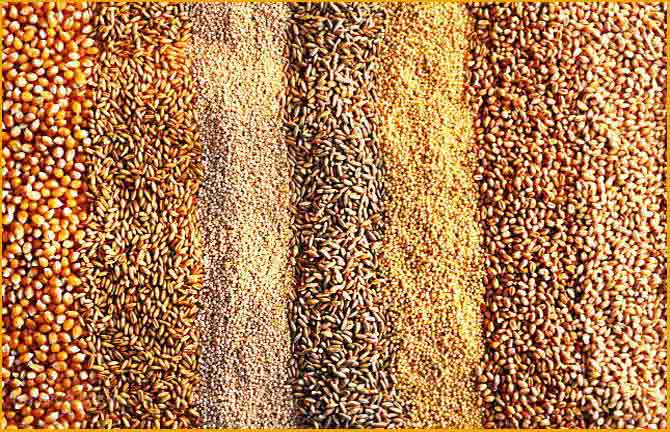
The specifics of breeding paduan
Paduanas do not hatch eggs. It is not typical for hens to take care of the offspring. Therefore, it is recommended to breed birds only when using an incubator. It is also permissible to find a chicken of a different breed and use it to hatch paduan. Sometimes farmers even use turkeys for this purpose. They are distinguished by a scrupulous attitude towards chicks.
Chicks hatch from 80-90% of the eggs. The chicks are tiny and healthy. The survival rate of the breed is 80-85%. Chickens are fast growing. They are covered with feathers in a short time, but they gain body weight rather slowly.
In the first days of life, birds need a lot of attention, they need specific care. While chicks are not thermoregulated, they should be kept warm. It is recommended to place the chicks in a box with dense walls. In this case, it is permissible to use a heating lamp. The temperature should be around 30 degrees. It is recommended to control the dryness of the litter. It should be changed several times a day.
From the 8th day of life, it is recommended to start lowering the temperature in the container by 2 degrees every day. In natural conditions, unheated chicks can be from 25 days of life. In winter, it will be possible to do without insulation from day 30.

It is recommended to feed chickens 5-6 times a day. The more often the chicks eat, the faster they will get stronger and begin to grow and become covered with feathers. From 4-5 weeks, the number of feedings is recommended to be reduced to 3 times. In this case, it is important to follow a clear scheme. The basis of the diet should be a mash of eggs and boiled millet. It is also worth adding green onions to the composition. This product is antibacterial and helps protect chicks from intestinal infections.
Cottage cheese will be a useful addition to the menu. It is required for the development of bone structures. From 3-4 weeks it is worth gradually introducing steamed compound feed into the menu. It must be distinguished by a special grind. The menu will have to introduce boiled vegetables.
In order for chicks to grow and develop normally, they need access to clean drinking water. It is worth adding additional components to it - ascorbic acid, glucose. Weak black tea will also be a useful ingredient. These supplements help improve digestive functions and strengthen the immune system.
Frequent illnesses
Birds are sensitive to dampness and cold.They can easily catch colds or get viruses. If you have contact with wild birds, there is a risk of contracting avian influenza. Birds hardly tolerate this disease. Proper nutrition, vaccinations and proper care will help protect against other diseases.
Chickens of this breed are very popular among fans of unusual birds. They have a characteristic crest on the head and a varied plumage color. In order for birds to grow and develop normally, they need optimal conditions for keeping. At the same time, it is recommended to properly organize the premises and provide adequate nutrition.
